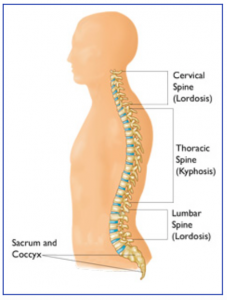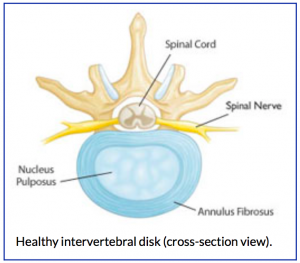Anatomy of the Spine
Understanding your spine and how it works can help you better understand some of the problems that occur from aging or injury. Many demands are placed on your spine. It holds up your head, shoulders, and upper body. It gives you support to stand up straight, and gives you flexibility to bend and twist. It also protects your spinal cord.
Spinal Curves
Your spine is made up of three segments. When viewed from the side, these segments form three natural curves. The “c-shaped” curves of the neck (cervical spine) and lower back (lumbar spine) are called lordosis. The “reverse c-shaped” curve of the chest (thoracic spine) is called kyphosis.
 These curves are important to balance and they help us to stand upright. If any one of the curves becomes too large or small, it becomes difficult to stand up straight and our posture appears abnormal.
These curves are important to balance and they help us to stand upright. If any one of the curves becomes too large or small, it becomes difficult to stand up straight and our posture appears abnormal.
Abnormal curvatures of the spine are also referred to as spinal deformity. These types of conditions include kyphosis of the thoracic spine (“hunchback”) and lordosis of the lumbar spine (“swayback”).
Scoliosis is another type of spinal deformity. When viewing the spine from the front or back, scoliosis is a sideways curvature that makes the spine look more like an “S” or a “C” than a straight “I.”
Intervertebral Disks
Intervertebral disks sit in between the vertebrae. They are flat and round, and about a half inch thick.
Intervertebral disks are made up of two components:
- Nucleus pulposus. The nucleus pulposus is jelly-like and makes up the center of the disk. The jelly is partly made of water and gives the disk flexibility and strength.
- Annulus fibrosus. This is the flexible outer ring of the disk. It is made up of several layers, similar to elastic bands.
When you are standing or moving, weight is put onto the nucleus. In response, the nucleus expands. The annulus holds the nucleus in place. This allows movement to take place, yet maintains the strength of the spine. In effect, disks act as shock absorbers for the spine.
The intervertebral disk is a very important structure. Many nerve endings supply the annulus and, as a result, an injured annulus can cause pain.
Adapted from http://orthoinfo.org/topic.cfm?topic=A00575
